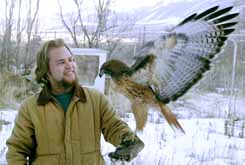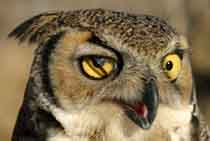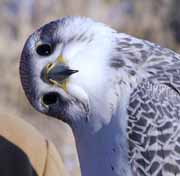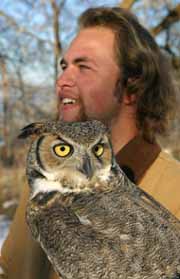Student falconer dedicates life to birds
To most people, being called a birdbrain would most likely be an insult, but for Luke Smith it is what he does best.
This senior in the wildlife management program at Utah State University spends whatever free time college life will allow as a falconer and wildlife educator. He currently cares for five different birds.
Smith has lived around birds of prey all his life; his dad was involved in falconry when Smith was growing up in the Uinta Basin, near Flaming Gorge. He raised fancy pigeons and other birds while his dad was a falconer.
“My dad was the only person in the area who did anything of the kind,” he said. “The Division of Wildlife Resources needed someone in our area to help with rehab, so they invited us to do it.”
At the age of 14, Smith got involved in falconry as well.
“I was just waiting until I was old enough,” he said. “I had all my applications for permits and supplies all ready to go.”
Smith said working with birds is divided up into three general categories: wildlife rehabilitation, falconry and wildlife education.
The first field is generally just taking care of injured animals, in Smith’s case birds. He started when he was 13 years old working with his dad to help with rehab.
As he moved into falconry he became more knowledgeable about the birds and what it takes to train and hunt with them.
“Falconry is one of the oldest sports known,” Smith said. “They have dated it back for years, but never been able to find out exactly when it started.”
The sport is usually related to royalty as an alternative means to hunting with guns, but it can be found in every part of the world, including Europe, Asia and the Middle East.
Smith’s hunting birds, a gyre falcon and a red-tailed hawk are used by permit of the federal and state divisions of wildlife, along with a great horned owl, which he uses for wildlife education programs and a bald eagle and Harris’ hawk, both of which he cares for as part of a rehab program.
The hunting birds, particularly the gyre falcon named Jalad (Arabic for executioner) are some of Smith’s favorites.
“[The falcon] uses updrafts in the air to reach heights of more than 1,000 feet,” he said. “Then we use pointer dogs to flush grouse or other birds out of bushes. As the falcon is circling, he sees the grouse fluttering scared in the air and dives after it.”
Falcons can dive at speeds of up to 190 mph under normal circumstances, Smith said. During some tests with skydivers the birds have reached more than 300 mph.
“It is awesome to look up and see the bird diving through the sky. I love the sound it makes,” he said, reproducing the sound with an airy whistle.
Along with rehabilitation and falconry, Smith also participates in wildlife education by taking the birds to schools and other events.
While his great horned owl is perched on his fist, Smith explains why his lifestyle is so great.
“I love showing the kids the birds and seeing their eyes light up,” he said.
A lot of presentations about birds are done in big auditoriums. The presenter usually lets the bird fly around a little and then shows some slide shows. But Smith has a different style.
“I would rather take a couple of days and go to each classroom,” he said. “That way the kids can come up and touch the birds and ask questions.
“I remember when someone brought a bird to my school when I was younger. I remember everything about that day, but I can’t remember anything else I learned in school.”
To be able to use the birds for educational purposes, the birds must learn that Smith is there to help them.
“They learn that I am always a source of food … They learn to trust me; that’s what it’s all about with birds of prey — trust,” he said.
The work educators do is an effort to educate everyone about wildlife. Many people wouldn’t consider hunting a good way to care for different animals, Smith said, but people need to be more informed about animal populations and their effect on the environment.
“I understand and appreciate these birds more than any environmentalist,” he said. “I understand how they live and what they need to live longer.”
Smith referred to a program called the Dedicated Hunter. This program teaches hunters about animal populations and what the good and bad effects of hunting are on a population.
For more information about falconry or wildlife education e-mail Smith at LJS@cc.usu.edu.
–jacobomoon@cc.usu.edu

Luke Smith handles Bloomy, a red-tail hawk, at the mouth of Green Canyon.

A membrane on an owl´s eye acts as a windshield wiper to help it see.

Jalab, “executioner” in Arabic, a gyre falcon, twists its head to see better.

Falconer Luke Smith is seen with Moopage, a great horned owl. (Photos by Cory Hill)

